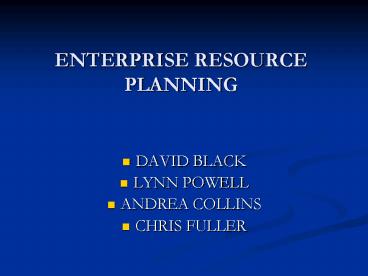ENTERPRISE RESOURCE PLANNING - PowerPoint PPT Presentation
1 / 12
Title:
ENTERPRISE RESOURCE PLANNING
Description:
... a software system that hooked P&G up to Wal-Mart's distribution centers. ... If you can't convince people that using software will be worth their time, they ... – PowerPoint PPT presentation
Number of Views:31
Avg rating:3.0/5.0
Title: ENTERPRISE RESOURCE PLANNING
1
ENTERPRISE RESOURCE PLANNING
- DAVID BLACK
- LYNN POWELL
- ANDREA COLLINS
- CHRIS FULLER
2
- Enterprise Resource Planning Definition
- ERP is a software system that organizes and
manages a companys business processes - ERP integrates departments and functions into a
single database to share information facilitate
communication - Functional areas traditionally include
sales/marketing, production, finance/accounting,
and human resources
3
Example Lands End, an E-tailer of stock and
monogrammed clothing
Personnel Payroll/Benefits
Human Resources
Online Order
Finance/Acctg.
Production
Inventory Fulfillment Shipping/Scheduling
Budgeting Profitability Analysis
Sales/Marketing
Forecasting Pricing
4
Benefits of ERP
- process integrationinternal external
- error reductionelectronic data transfer
- real timeimmediate data processing
- efficient mgmt of resourcestime, data, labor,
money - efficient simplified processes/production
- expedited customer service
- links to
- supply chain management (SCM),
- customer relationship management (CRM),
- collaborative product commerce (CPC), and
- material requirements planning (MRP)
5
Cost Obstacles of ERP
- Run away costs, long implementation times poor
outcomes - Historically in the millions and billions 7-10
year project - Meta Group Study63 sm/med/lrge cos. Surveyed
- TCO total cost hardware, software, prof.
services, staff - Average cost 15 million
- Range 400,000 - 300 million
- Industry Specific Templatesoffered at fixed
price fixed timetable - eCompany installed 4 modules in 3 weeks 200,000
- Interactive Apparel installed 4 modules in 9
weeks 150,000 - Access ERP software via Internet portals and
application service providers (ASPs)
6
Who/What is blamed for ERP Failure?
- The ERP system itself the actual software
- Vendors
- Implementing Consultants
7
ERP/SCMWhy did so many companies fail?
- Ignoring the importance of defining the process
- Neglecting to build a solid implementation
program - Getting the buy in from all levels of the
organization- Assuming that implementation is a
technical issue - Trying to adapt the ERP process to work in their
business, even if it doesnt fit - Trying to adapt the business to fit the ERP
technology - Circumventing the system
- LACK OF TRAINING trying to save money time
8
- Case Study Mattress Giant
- Problem
- ID Customer Base
- Halted implementation of ERP project
- Solution
- Got elbow-deep in the business
- Partnered with CFO
- Partnered with ERP vendor GERS Retail Systems
- Reengineered the IT function and rejuvenated
spirit of excellence in technical support. - Prepared Business Metric Reports
- Deliverables
- CEO accepted new ERP system
- Found new customer Demographics
9
- What are the hidden costs of ERP?
- Training
- Integration and testing
- Customization
- Data Conversion
- Data Analysis
- Consultants ad infinitum
- Replacing your best and brightest
- Implementation teams can never stop
- Waiting for ROI
- Post-ERP depression
10
- How do companies organize their ERP projects?
- The Big Bang
- Companies cast off all their legacy systems at
once and install a single ERP system across the
entire company. - Franchising Strategy
- The most common way to implement ERP. Suits
large or diverse companies that do not share many
common processes, such as financial bookkeeping.
Links together only information necessary for
the corporation to get a performance big picture
across all business units. Takes a long time. - 3. Slam Dunk
- For smaller companies expecting to grow into
ERP. Goal is to get ERP up and running quickly
and to ditch the fancy reengineering in favor of
the ERP systems canned process.
11
What is Supply Chain Collaboration? Example
Wal-Mart and Proctor Gamble These two giants
built a software system that hooked PG up to
Wal-Marts distribution centers. When PGs
products run low at the centers, the system sends
an automatic alert to PG to sip more products.
In some cases, PG can monitor individual
Wal-Mart stores with real-time satellite link-ups
that send messages to the factory whenever a PG
item swoops past a scanner at the register.
12
- What are the roadblocks to installing Supply
Chain Software? - Internal resistance to change
- If you cant convince people that using software
will be worth their time, they will easily find
ways to work around it. - Many mistakes at first.
- Forecasters stop trusting the system and work
with their own data.































